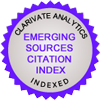LiDAR sensörünün hiperspektral verilerden gölgelik alan çıkarımı başarımına etkisi
Seniha Esen Yüksel, Mustafa BoyacıHacettepe Üniversitesi, Elektrik ve Elektronik Mühendisliği Bölümü, Ankara, TürkiyeHiperspektral görüntülerin analiziyle, tek bir pikselden o pikseldeki materyalin ne olduğu anlaşılabilmektedir. Bu özelliğiyle hiperspektral görüntüleme, yeryüzünün uzaktan algılanmasını gerektiren jeoloji, zirai ve askeri alanlarda, özellikle sınıflandırma ve hedef tespiti uygulamalarında tercih edilen bir yöntem olmaktadır. Ancak, hiperspektral görüntülemede gölgelik alanlarda kalan hedeflerden çok az miktarda foton yansımakta, bu yüzden de toplanan spektral verilerin genlikleri çok düşük düzeylerde kalmaktadır. Bu durum, gölgede kalan hedefin bulunamamasına neden olabilmektedir. Özellikle yüksekliğin sık değiştiği yerleşim yerlerinden alınan verilerde, gölgelik alanların etkisinin sınıflandırma başarımına etkisi katlanarak artmaktadır. Bu çalışmada, gölge tespiti yapan iki algoritma geliştirilmiş ve karşılaştırılmıştır. İlk yöntemde, hiperspektral verilere ek olarak LiDAR sensöründen alınan veriler de kullanılmıştır. LiDAR verilerinden gölge tespiti amacıyla, hiperspektral verilerin toplanma anındaki güneşin açılarını ve ortamdaki yükseltileri dikkate alan bir görüş hattı algoritması geliştirilmiştir. İkinci yöntemde ise, gölgeler sadece hiperspektral veriler kullanılarak tespit edilmiştir. Öncelikle bir referans imza oluşturulmuş, sonra diğer pikseller bu referans imzaya olan uzaklıklarına göre sınıflandırılmıştır. Sonuçta, hiperspektral görüntüdeki gölge alanlar tespit edilmiş ve iki yöntemin eşleşme sonuçları ve güvenilirlikleri karşılaştırılmıştır.
Anahtar Kelimeler: LiDAR, Hiperspektral, Gölgelik alanlarEffect of LiDAR sensor on the success of shadow detection from hyperspectral data
Seniha Esen Yüksel, Mustafa BoyacıDepartment of Electrical and Electronics Engineering, Hacettepe University, Ankara, TurkeyWith the analysis of hyperspectral images, it is possible to understand the underlying material from a single pixel. Due to this characteristics, hyperspectral imaging (HSI) is becoming a preferred method in geology, agriculture and defense fields which require the remote sensing of the environment for the purposes of classification and target detection. However, in HSI images, there are only a few photons that get reflected from areas that are under shadow. Hence, the amplitudes of the spectral signals received from shadow areas are very small, which leads to tremendous difficulties in target detection in shadowy areas. These difficulties become much more pronounceable in areas with varying elevations. In this study, we developed two methods to find the shadow regions in hyperspectral images and compared their results. The first method, line-of-sight, uses an external sensor, the Light Detection and Ranging (LiDAR), which provides elevation information. We use the LiDAR data and detect the shadows at the time of the hyperspectral data collection. Then we match the shadows to the hyperspectral image using UTM coordinates. The second method uses only the hyperspectral data and compares each pixel to a pre-determined shadow signature to arrive at a shadow/non-shadow decision. Comparison of both methods gives insight into the reliability of both methods and allows to better deal with the shadows in hyperspectral data.
Keywords: LiDAR, Hyperspectral, Shadowy areas, Line of sightSorumlu Yazar: Seniha Esen Yüksel, Türkiye
Makale Dili: Türkçe






